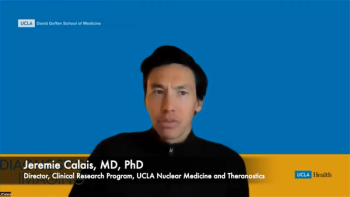
State of the art: Treatable tumor size increases; RFA versus cryoablation question emerges
The case for radiofrequency ablation and other forms of tumor ablation has been made: Use of the technique is established for treating bone lesions and tumors of the liver, lung, kidney, and other organs. Now the focus turns to expanding the realm of treatment and pushing the limits of the technology. Two areas taking center stage are tumor size and the choice between RFA and cryoablation.
The case for radiofrequency ablation and other forms of tumor ablation has been made: Use of the technique is established for treating bone lesions and tumors of the liver, lung, kidney, and other organs. Now the focus turns to expanding the realm of treatment and pushing the limits of the technology. Two areas taking center stage are tumor size and the choice between RFA and cryoablation.
TREATING LARGER TUMORS
Current standard practice suggests using RFA or other ablation modalities to treat tumors no more than 5 cm in size. But improved equipment and new technologies are prompting some physicians to treat larger lesions.
Generators now generally run at 200 watts, which physicians credit for speeding up ablation times.
"With the newer machines, most ablations are done in seven to 15 minutes. The older machines would take a lot longer to get up to adequate temperatures," said Dr. Paul Dale of the Ellis Fischel Cancer Center.
These faster ablation times enable practitioners to tackle larger tumors. Dale and his colleagues have treated tumors up to 7 cm. Other facilities, such as the Cleveland Clinic, have treated tumors as large as 10 cm.
New technology that allows physicians to use multiple needles at the same time or arrays with two to three needles on the same base can also make handling a large-volume tumor easier.
Even with more powerful generators and multiple needles, however, the time needed to treat large-volume tumors is not insignificant. A 3-cm tumor may take 15 minutes to treat, but an 8-cm tumor may require up to four or five hours to fully destroy, said Dr. Jason Williams of the American Cancer Ablation Center in Gulf Shores, AL.
"I try to ensure that I get all the outer margin of a tumor. You figure if you ablate the entire circumference of the tumor, there's not a good source for it to get blood," he said. "You're essentially isolating the tumor. You're more likely to get a better ablation. If you cut off the blood flow, often your ablation goes faster."
These cutting-edge technologies also demand a new approach to ablation.
Physicians have enough experience with single-needle ablations to judge where the sphere of treatment will be, even if they can't see the ablation in real-time with MR or CT, said Dr. Matthew Callstrom of the Mayo Clinic.
"When you put two needles in, you have additional variables. You could say, I think a sphere is roughly here and here, but what's going on between, what's going on at the edges? It will take time to gain that experience so you can anticipate well if you can't monitor the ablation while you do it. If you put in two electrodes and you're doing two 4-cm ablations, now the stakes go higher for collateral damage," Callstrom said.
WHEN TO USE RFA AND WHEN TO USE CRYO
RFA is certainly the most studied and widely used form of tumor ablation, but other methods are proving to be more effective in certain cases. In treating bone tumors, for example, many physicians prefer cryoablation over heat-based technologies.
Cryoablation tends to be significantly less painful than RFA when ablating a bone lesion, Williams said.
"In the past, I've done bone lesions with RFA, but I'm finding better results with cryoablation," he said. "The freezing works so there's a natural anesthetic. Patients seem to have a faster reduction in their pain."
In addition, cryoablation allows more accurate visualization of the extent of the ablation. With CT, seeing the margins of treatment can be impossible, Callstrom said. But with cryoablation, practitioners can precisely visualize the ice ball and see exactly what they're treating.
For this reason, some physicians recommend cryoablation for lesions in the lower anterior region of the kidney. Tumors in this location may be too close to the bowel, ureter, and other structures for use of RFA.
"When the tumor is well away and we don't have to worry about hitting these structures, RFA is what we use," Callstrom said. "Near these structures, we use cryo. You can visualize the ice ball, so you don't actually get into those structures. You won't hit the bowel if you can see it."
Cryoablation is not recommended for lesions in some areas, however. In treating the liver, cryoablation carries risks that RFA does not, said Dr. Allan Siperstein, head of endocrine surgery at the Cleveland Clinic.
"The difficultly of cryoablation is that when the ice ball thaws, there's a washout of a lot of dead cellular material into the circulation," Siperstein said. "It can cause coagulopathy, and when you freeze the liver you can sometime fracture it. These are not problems with RFA."
Newsletter
Stay at the forefront of radiology with the Diagnostic Imaging newsletter, delivering the latest news, clinical insights, and imaging advancements for today’s radiologists.




























